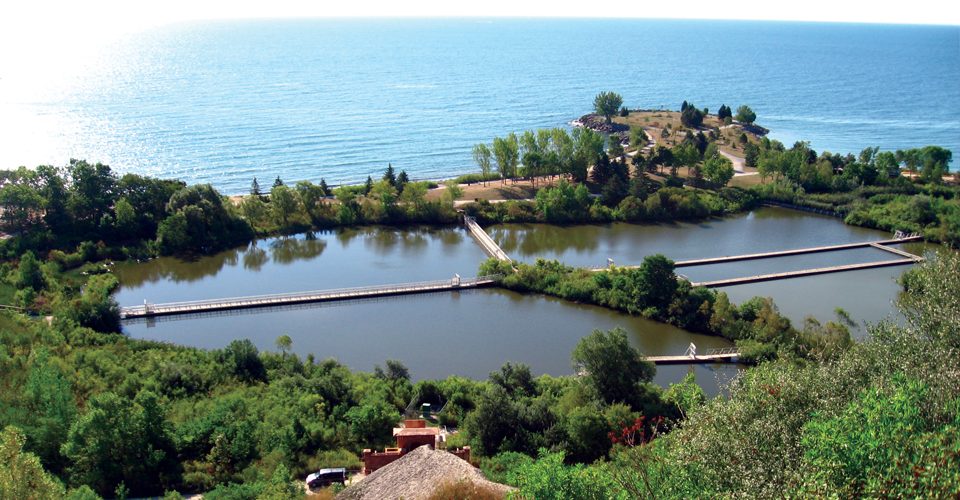YOU JUST TOOK A WATER BALLOON TO THE FACE. The good news is that, as a Canadian, you are rarely so pressed to think about the quality and abundance of your water. Globally, there is enough clean and fresh water for everyone. Nevertheless, huge shortages remain in many parts of the world due to the naturally uneven distribution of the water cycle (among other factors). Even more problematic, the cycle is easily disrupted: small climatic shifts can quickly bring too much or too little, wreaking havoc on conventional water management systems.
YOU JUST TOOK A WATER BALLOON TO THE FACE. The good news is that, as a Canadian, you are rarely so pressed to think about the quality and abundance of your water. Globally, there is enough clean and fresh water for everyone. Nevertheless, huge shortages remain in many parts of the world due to the naturally uneven distribution of the water cycle (among other factors). Even more problematic, the cycle is easily disrupted: small climatic shifts can quickly bring too much or too little, wreaking havoc on conventional water management systems.
These systems are proving inadequate to the challenges created by climate change. Because Canada has been spared the harshest impacts (so far), we are largely unprepared for major water cycle shifts. Fortunately for us, there are lessons to be learned from many communities (including a few homegrown examples) that have already adopted decentralized water management strategies. What we need to absorb are not the designs themselves, but the principles of resilience and low-impact development, which are essential to building a water system that can withstand shocks.
To clarify, the concept of decentralized systems is intended as a geographical distinction rather than a political one. In this context, both centralized and decentralized systems can refer to public or private and municipal or federal initiatives.
Most Canadian cities use water from a single source and dispose of it in a single location. The system works well enough under normal circumstances; there’s no real need to recycle when freshwater remains in ready supply. This centralized structure, however, is like an 18-wheeler on a treacherous highway, struggling to cope with changes in speed and direction. Enough of both, and it might crash.
Increases in the intensity of flooding, droughts and storms are all expected impacts of climate change on water cycles. “New patterns of wind, humidity, and ambient temperature are already dramatically altering the weather map,” wrote Chris Wood, author of Dry Spring: The Coming Water Crisis of North America, in a 2005 article. “Some parts of the country are receiving more rain than ever before; other regions are drying up.” Moreover, Wood argues that “Canada’s multibillion-dollar investment in water infrastructure” is already outdated: “It will not be able to either contain the massive floods or ameliorate the droughts of the future.”
No, perhaps not. An anecdote from our nation’s capital may help explain why.
For most of one day in early September 2012, it rained heavily in Ottawa – not an uncommon event for the time of year, or one likely to raise alarms. Yet the capital region’s residents were unpleasantly surprised to find that the rainfall had caused 63.5 million litres of diluted sewage to overflow into the Ottawa River. Ottawa’s stormwater system is typical of a mid-sized Canadian city: made up of no less than 1500 kilometres of pipes, including some overlap with the sewage system. The labyrinth of pipes is not designed to handle large influxes of water, and the results are more or less catastrophic when it happens.
Like most of the world, Canada’s cities are ill equipped to handle sweeping problems such as contaminated water supplies and widespread flooding. Ottawa’s sewer system can’t cope with an enormous rain deluge any more than India’s water reserves can withstand weeks of drought. Centralized systems are vulnerable to climate change conditions because the size and nature of the infrastructure makes adaptation difficult. Breaking water management structures down into discrete, independent and decentralized systems builds resilience against fluctuation.
Ask international sanitation consultant Julian Doczi about decentralized water management and he will fire back with his own questions: What is the current regulatory environment? What are the specific physical terrain features and urban density of the local area? Do the households we wish to connect own their own land or are they squatters?
“The point,” explains Doczi, “is that … decentralized systems are only as useful or appropriate as their specific local circumstances dictate.”
In fact, decentralized systems can be anything from a rain barrel to a complex water-cleaning tank. They typically collect and/or treat water at the source and are designed to maximize efficiency by mimicking or taking advantage of natural water cycles. Decentralization has been gaining traction in low-resource regions of the world as a means of stabilizing water intake and output, while reducing the risk of large-scale failure.
1. Ecotanks
These self-contained wastewater treatment systems bear a remarkable resemblance to miniature submarines, but are typically no bigger than an average septic tank. In densely populated Bangkok, the tanks are installed underground. With space at a premium, the system is ideal because it works below the community it serves and without the need for expensive infrastructure to reach far-flung regions.
Pipes stretch like roots toward neighbouring houses, bringing back the untreated sewage that would otherwise be dumped into nearby waterways. Ecotanks pass water through cells containing anaerobic bacteria, which transforms wastewater that would otherwise be too contaminated for use into a much cleaner effluent.
Individual communities often don’t possess the financial or social capital to demand a connection to larger systems. The Ecotanks project puts control firmly in the hands of its users. Locals build the tanks to their own specifications (modifying the original Japanese technology), and their distribution has expanded into neighbouring countries with the aid of project donors. The City-to-City Cooperation program has taken responsibility for educating locals about tank usage and maintenance, the cost of which will eventually fall on the
city administration.
2. DEWATS
Alternative Food Process Pvt. Ltd. is a gherkin processing plant in Doddaballapur, near Bangalore, India. The facility sits in a region with no potable water and few available mechanics. It must therefore clean its water with a minimum of necessary maintenance. One of the advantages of decentralized systems is that they are potentially, although not necessarily, low-maintenance. It’s an important consideration where such resources are at a premium.
The gherkin plant’s solution is DEWATS (Decentralized Wastewater Treatment Systems), an innovation of the German-based, Bremen Overseas Research and Development Association (BORDA). That group has compressed an established technology and allowed it to be detached from the usual mass of infrastructure. These systems feature several locked-in technical specifications (a sedimentation section, followed by anaerobic and then aerobic treatment), plus a series of mechanical and material options for mixing and matching to suit the demands of a specific location.
Wastewater is collected in tanks where particles are allowed to settle to the bottom. Water-borne pathogens are degraded in the system’s first section and passed through to the planted gravel filter, which performs even more degradation of organic matter and removes pathogens. A polishing pond kills remaining pathogens with ultraviolet radiation, and the water can then be reused for gardening and other non-potable uses.
3. Urban Parks as Flood Control
Curitiba, Brazil, had been throwing money at its water problem for years. The city was growing so rapidly and creating so many impermeable surfaces that government staff and programs couldn’t keep up with the frequent flooding and resulting water-quality issues. Pressed by a growing problem, they decided to put their abundant green spaces and abandoned quarries to work. Whereas excess water was previously diverted to treatment facilities, the city has built a series of parks and lakes out of these underused spaces to retain water during peak flows. The 20 km2 of green space alongside the Iguaçu River is now one of almost 30 parks that absorb untold quantities of water.
The parks and lakes have proven popular and capable of handling a range of water levels. Excess water has become an asset, contributing to the wellbeing of the city.
While it may seem that lakes, tanks and customized treatment systems have little in common, they belong to the same family of water management techniques. The physical designs of these systems are founded on a set of principles – flexibility, resilience and redundancy – which act in concert to mimic the natural water cycle.
System designs will ideally use existing topographical features to their advantage. “Often natural treatment systems – such as constructed wetlands, planted gravel filters, etc. – can be incorporated into the system and the landscaping of the area,” says Lisa Lumbao, senior water and sanitation advisor at AECOM. “In other cases, the system can be built underground to save space.”
Still, water management has no silver bullet. Curitiba had the space and funding for a massive landscape overhaul, but such a solution would fall flat in crowded Montreal or poor, rural India. The principles of decentralization, however, have already begun to trickle into our northern sanctuary.
Canada has a modest mix of decentralized water management projects, some in response to long-standing problems, and others which arose out of forward thinking and threat anticipation. With a mass of established infrastructure, Canada has the technological capacity, but many more impediments to new construction.
4. Dunkers Flow Balancing System
The Toronto Region Conservation Authority (TRCA) helped create the Stormwater Assessment Monitoring and Performance Program (appealingly known as SWAMP) after rapid urban growth in the 1980s, which created water cycle fluctuations that have been linked to quality issues and the devastation of fish ecosystems. Water-related shocks are now being anticipated: “We can foresee problems in a changing climate,” says Sameer Dhalla of the TRCA. “Altering the water balance, sometimes just three to five per cent, can cause significant problems, and climate change can contribute to that.”
The Dunkers Flow Balancing System is one discrete tool that aims to absorb these variations. Now monitored closely through SWAMP, the intricate system takes in and cleans both stormwater and sewage overflow by passing it through a series of cells with progressively finer sedimentation filters. The system’s greatest advantage is location: Dunkers is smack in the middle of the mud and algae of what was previously a degraded wetland on the edge of Lake Ontario.
“It allows you to use space that is otherwise non-existent,” says project manager Tim Van Seters, referring to degraded wetlands, which are not exactly in-demand real estate. The Dunkers facility is connected to and set slightly above the level of the lake, “so that water can flow directly into the system when lake water levels are high.”
5. Rainwater Gardens
In Halifax, sewage and stormwater are combined, meaning that both forms of wastewater share the same pipes, and both spill directly into the harbour after heavy rains, often overwhelming the nearby treatment plants. The key to dealing with overflow episodes, says Ashley Sprague, restoration coordinator with Halifax’s Ecology Action Centre, is to “give the stormwater a chance to slow down so that it can be filtered by plants and absorbed into the ground,” thereby decreasing the strain on the sewer system.
It’s easier said than done: Halifax is essentially a giant hill with a harbour at the bottom. So the city has employed a series of rainwater gardens as ecological speed bumps. The gardens contain plants – in this case, native species such as maidenhair fern, red-osier dogwood and swamp milkweed – that thrive on being nearly drowned from time to time. After infiltrating and being partially soaked up by thirsty plants, the water sinks back into the groundwater and rejoins the water cycle.
6. Low-Impact Building
Station Pointe Greens, a mixed-use housing complex in Edmonton, is essentially an attempt to create an “invisible building.” The massive urban rejuvenation project is being designed to reuse all of its water, in addition to collecting rainwater from the roof – a significant feature, given that buildings account for 12 per cent of all non-industrial water use in Canada. Bioretention systems and permeable surfaces will ensure that the building poses a minimal disruption to the water cycle.
The North Saskatchewan River is the city’s only source of water, and the long-term stability of the water supply is a concern. Green building experiments like Station Pointe Greens reflect the city’s shift in management philosophy from efficiency to conservation, as fears rise that climate change will force the city to find new sources of water.
Rather than develop a system that attempts to work around and otherwise mitigate a building’s impact on the water cycle, Station Pointe Greens will treat the built environment as an asset: a self-sufficient piece of infrastructure with the ability to withstand changing conditions.
We can’t yet see the full impact that climate change will have on Canada, but we’ve at least had a peek. Some communities have started to implement more efficient forms of water management, building resilience into the system. The aim is to see the principles of decentralization embraced country-wide.
A mass of political and economic considerations is intertwined with our septage systems, making full-scale change a difficult proposition. Moreover, most people don’t like to explore sewers in any kind of literal or figurative sense. Infrastructural change is always slow, and is perhaps best achieved in this case by constantly adding decentralized solutions to supplement our current systems.
Of course, the complete absence of clean water is a very powerful motivator. In Bangkok, Curitiba and Doddaballapur, the decentralization shift became an urgent necessity. And water problems will arrive in Canada as inevitably as they have in the rest of the world.
The advantage of decentralization is that a national impetus is not an essential requirement. Rainwater gardens in Saint John, water barrels in Regina or stormwater plants in Vancouver are all dots on the water cycle landscape. The more dots we can put on the map, the greater the resilience of water management systems.
Meanwhile, a river of sewage floating through Ottawa should be quite enough to raise the national alarm. If not, we may need to start throwing water balloons.
There are many household-scale tools for managing water sustainably. At ground level, permeable pavement can be installed to divert rainwater from the sewer system, and drought-resistant plants can reduce or eliminate the need for watering (aka xeriscaping). Above ground, rain barrels can be deployed to reuse runoff, and rooftop gardens (aka green roofs) can collect rainwater, cut heating costs and extend the lifespan of a roof. To research more solutions, start with Credit Valley Conservation’s low-impact development guides (creditvalleyca.ca), or the Ecology Action Centre’s stormwater management blog (managingstormwater.blogspot.ca).
Read Stu Campana’s A\J blog posts on renewable energy.

Stu Campana is an international environmental consultant, with expertise in water, energy and waste management. He is the Water Team Leader with Ecology Ottawa, has a master’s in Environment and Resource Management and writes the A\J Renewable Energy blog. Follow him on Twitter: @StuCampana.












